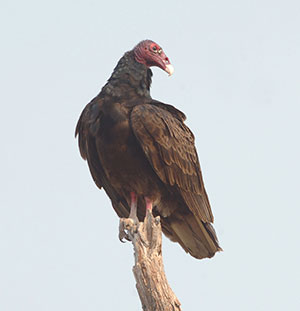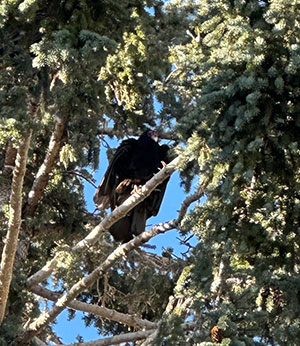
Contact Us
Institutional Communications
Bureau of Mines Building, Room 137
Laramie, WY 82071
Phone: (307) 766-2929
Email: cbaldwin@uwyo.edu
UW Biodiversity Institute to Host Vulture Watch Wyoming Training April 27
Published April 12, 2024

UW’s Biodiversity Institute invites community members from across the state to
share their observations of turkey vultures through a new program called Vulture Watch
Wyoming. A training session will be held Saturday, April 27, from 10 a.m.-noon in
person in the Berry Biodiversity Conservation Center auditorium and will be livestreamed
on Zoom. (Eddie Bartley Photo)
When people think of turkey vultures, images are often conjured of the scavenger birds picking at an animal carcass on the side of the road. However, these often-misunderstood raptors provide key benefits to the environment.
“When you see a turkey vulture picking at an animal carcass, it is actually serving a really important role -- scavenging,” says Elizabeth Wommack, curator and collections manager of vertebrates for the University of Wyoming’s Museum of Vertebrates. “Animal carcasses can pose a health and environmental hazard if there are too many left in an area, and scavengers of all shapes and sizes help in recycling the material from the carcass back into the ecosystem.”
UW’s Biodiversity Institute invites community members from across the state to share their observations of these fascinating birds through a new program called Vulture Watch Wyoming. A training session will be held Saturday, April 27, from 10 a.m.-noon in person in the Berry Biodiversity Conservation Center auditorium and will be livestreamed on Zoom here.
While turkey vultures play a vital role in the ecosystem of Wyoming, understanding of a good deal of their basic biology and behavior in the state is scarce. Because they are a wide-ranging species that may travel hundreds of miles per day, collecting data on them throughout the state becomes a huge task, Wommack says.
In early to mid-April, turkey vultures arrive in Laramie after migrating from wintering grounds in Central America and South America. The birds have a communal roost -- they occupy a series of trees on the southwest corner of UW’s campus -- which they use until migrating back to their winter grounds in September and October. Communal roosts are important gathering places for the birds, providing them a safe place to sleep; allowing them to take care of their daily tasks, such as stretching and cleaning; and possibly sharing information about the location of resources, Wommack says.
“We are asking volunteers to help us gather basic information on turkey vultures that they see to help us start to figure out where and what types of habitats they are found in; what different types of behavior they are doing there; and how many adults and juveniles they may find,” Wommack explains. “This type of data will aid us in understanding the breeding and habitat use of turkey vultures across Wyoming.”
Volunteers will use a mobile survey app with specific questions, including where turkey vultures select their roosts. Volunteers also will help identify which species of trees the birds use; what types of behavior they perform at their roosts; and record information on locale, time and weather condition.

This turkey vulture was spotted roosting in a tree in the southwest corner of
UW’s campus. In early to mid-April, turkey vultures arrive in Laramie after migrating
from wintering grounds in Central America and South America. (Elizabeth Wommack Photo)
“There is much to learn about roost dynamics, breeding behavior and how they interact with their habitat,” Wommack says. “Whether you spend a few minutes observing their communal roost, watch them soar or you find roost sites, the reported observations will help researchers at the University of Wyoming Museum of Vertebrates and the Biodiversity Institute build a better picture of where these important birds are found in Wyoming.”
Wyoming has many species of animals that are opportunistic vertebrate scavengers -- such as bald eagles, common ravens, coyotes, bears and mice -- but only the turkey vulture is considered an obligate avian scavenger, Wommack says.
The main part of turkey vultures’ diets is cleaning up dead animals across the landscape. They have a keen sense of smell and can track carcasses by sight and smell. They also have an amazing gut and digestive system, which has been proven to remove from the environment diseases, such as anthrax and botulism, that can be found in carrion, she says.
“Cathartes, the genus of turkey vultures, means ‘purifier’ in Greek,” Wommack says. “And that is what they do. They help us clean up and purify the landscape.”
For more information about Vulture Watch Wyoming, email Wommack at ewommack@uwyo.edu.
About the University of Wyoming Biodiversity Institute
The UW Biodiversity Institute fosters conservation of biodiversity through scientific discovery, creative dissemination, education and public engagement. In this setting, scientists, citizens, students and educators come together to share a wealth of perspectives on the study and appreciation of biodiversity -- from microbes to poetry and ecosystems to economics. Learn more at www.wyomingbiodiversity.org.
Contact Us
Institutional Communications
Bureau of Mines Building, Room 137
Laramie, WY 82071
Phone: (307) 766-2929
Email: cbaldwin@uwyo.edu
